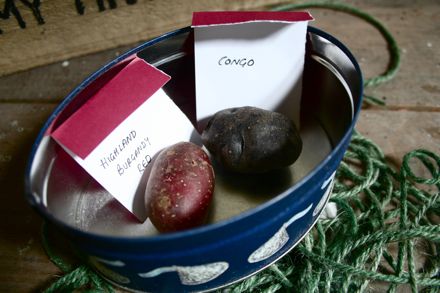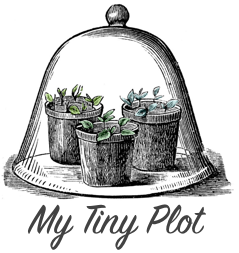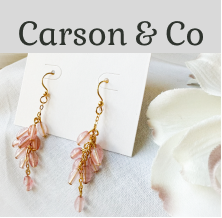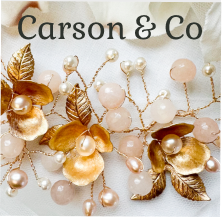How to Save Seed Potatoes

While I was on a pruning course a few weeks ago I met a very interesting guy called Bill Whitehead. He knew tons and tons about Potatoes and their history in the UK. He showed me an example of the oldest known variety of Potato still grown in the UK – The Yam. It dates from 1771.
He also gave me two Potatoes to save and plant next year. They were a black variety called Congo and a red variety called Highland Burgundy Red. I’ve always understood that it’s risky to save your own Potato seed because you risk building up disease and that it’s better to buy disease-free seed from a merchant – which I normally do. However, since I’ve been given these interesting varieties I thought I would have a go at saving them for next year.
It seems you need to keep a few things in mind:
- Put them in the light first to let them go a bit green (to encourage dormancy)
- Store them in a dark, frost-free place
- Ensure that air can circulate around them (storing in egg boxes is a good idea)
There is quite a nice post about saving Potato seed here.
So I’m going to give it a go. If I’m drowing in a sea of Blight come this time next year, I give you full permission to say, ‘I told you so!’.
 My Tiny Plot
My Tiny Plot



are you my fairy godmother? we dug up the last of our spuds this morning and came home to google ‘how to save seed potatoes’ once I’d caught up with my reader. I’ll be saving our red skinned robinta for next year and if it’s any reassurance one of the old boys on our allotment has used the same potatoes for 4 years with no incidence of disease
Alot of people save their own potatoes. I’m still trying to find one which the slugs don’t like!
The potato seed sellers definitely over-egg the dangers of saving your own potatoes. Well they would, wouldn’t they?
If you grow in a fairly exposed and/or windy spot, there’s no reason why you shouldn’t save your own seed; wind discourages aphids, which are the vectors of potato virus. Even if you do get a bit of virus, it’s several generations before you spot any serious reduction in yield… at which point you buy fresh seed.
No problem!
Oh my word, aren’t they handsome! And thank you for explaining the process. I saved a few of my earlies and then thought I’d done it wrong when they went green. DOH!
State-side diseases being spread from greenhouse grown plants this summer. In particular tomatoes grown in the Northeastern US, that were from commercial hot houses, have spread wilt that is systemic. Weather has also been a factor. The problem has been so severe that home growers are being encouraged to try and grow their own plants from seed. There are some farmers here who’ve had to plow under a whole summer’s harvest of tomoatoe and potatoes. What we are learning here in the US is that industrial agriculture is not, necessarily, sustainable agriculture.
Pingback: My Tiny Plot » Blog Archive » Do Potatoes Cross-Pollinate?
Pingback: Potting Plants » Blog Archive » Do Potatoes Cross-Pollinate?
Pingback: My Tiny Plot » Blog Archive » New (ish) Potatoes
Hi all,
Excuse my ignorance as this is the first year i have grown potatoes, well infact anything ha ha, but i dont really understand the term seed potatoes?!
Obviously i have determined that it is not an actual seed but i would like to know how to make my own.
Is it just a matter of keeping some of the crop? and when can you re-plant them????
Everyone i speak to says you can only plant them at certain times of the year but the supermarkets have a constant supply which would suggest they can be grow throughout the whole year?????
Regards